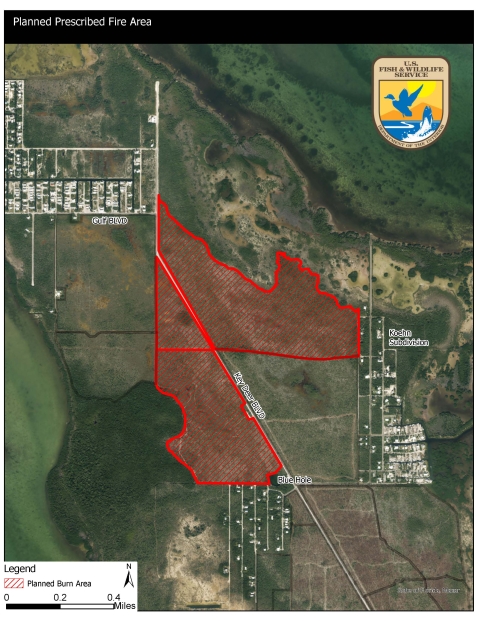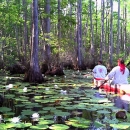The Refuge is located in the Lower Florida Keys, a hundred mile stretch of islands that extends south and west from south Florida. Habitats in the refuge consist of pine rockland forests, tropical hardwood hammocks, freshwater wetlands, salt marsh wetlands, and mangrove forests. National Key Deer Refuge is home to more than 20 endangered and threatened plant and animal species.
The endangered Key deer are the smallest subspecies of white-tailed deer that are found throughout much of North America. Key deer are unique to the lower Florida Keys, they are found nowhere else in the world.
Visit Us
National wildlife refuges offer us all a chance to unplug from the stresses of daily life and reconnect with our natural surroundings
National Key Deer Refuge is a wonderful place to see Key deer, other wildlife species, and rare habitats. The best place to start your visit is the Nature Center.
Nature (Visitor) Center:
National Key Deer Refuge/ Florida Keys National Wildlife Refuges
30587 Overseas Hwy
Big Pine Key, FL 33043
Open 10am-3pm, Wednesday- Saturday.
Driving Directions-
From Key West- head east/north on HWY US 1 to Big Pine Key. The Nature Center is located just past the only traffic light on the island, on the left (north) side of the road. Look for the blue Florida Keys National Wildlife Refuges sign.
From South Florida and upper Florida Keys- Take HWY US 1 south and west to Big Pine Key. The Nature Center is located just prior to the only traffic light on the island. Turn right, (north) into the Nature Center parking lot.
The Nature Center is accessible to all, and staffed with volunteers and refuge personnel who can answer questions and provide information. Staff and volunteers at the Nature Center can highlight areas of the refuge to visit based on what you are looking to do and see. The Nature Center is also home to our Friends group’s (Florida Keys Wildlife Society) nature store, filled with nature-oriented books and gifts. Proceeds directly benefit the four Florida Keys National Wildlife Refuges, including National Key Deer Refuge.
Location and Contact Information
What We Do
Wildlife conservation is at the heart of the National Wildlife Refuge System. It drives everything on U.S. Fish and Wildlife Service lands and waters managed within the Refuge System, from the purposes for which a national wildlife refuge national wildlife refuge
A national wildlife refuge is typically a contiguous area of land and water managed by the U.S. Fish and Wildlife Service for the conservation and, where appropriate, restoration of fish, wildlife and plant resources and their habitats for the benefit of present and future generations of Americans.
Learn more about national wildlife refuge is established to the recreational activities offered to the resource management tools used. Using conservation best practices, the Refuge System manages Service lands and waters to help ensure the survival of native wildlife species.
There are four main categories of management strategies employed at the National Key Deer Refuge to maintain, restore, and enhance the natural diversity and abundance of wildlife, plants and habitats. These strategies include: wildlife management, habitat management, education and outreach, and law enforcement.
Our Species
Key Deer
The endangered Key deer is the smallest subspecies of the North American white-tailed deer. They are the only large herbivore in the Florida Keys and can be found in every habitat, where they feed on dozens of native plant species. They travel through all of the Florida Keys habitats, and can walk, wade or swim from island to island. Despite the absence of predators, Key deer retain the characteristic behavior of raising their tails when alarmed, revealing the white fur underneath. Competing males joust for females during the rut by locking antlers. Breeding occurs in the fall; with the majority of white–spotted fawns born in the late spring and summer months.
Poaching and habitat loss had reduced the number of Key deer to only a few dozen animals by the 1950’s, but establishment of the Refuge and subsequent listing of the deer as endangered in 1967 has allowed for protection and a dramatic recovery of the species. The deer are most concentrated on Big Pine and No Name Keys, where an estimated 75% of the population lives. This high density of deer and proximity to homes and roads results in motor vehicle collisions, especially at night when the deer are more active. Please drive carefully when in Key deer country (Big Pine-Lower Sugarloaf Keys). Human interactions with deer such as illegal feeding have conditioned many deer to approach humans, leading to unhealthy conditions. Please help the Key deer by not feeding them, and help us spread the word about how important this is to maintaining a healthy deer population.
Seasons of Wildlife
Although the Florida Keys are located in a subtropical environment, we are still influenced by seasonal changes that affect most of the country. Depending on the season, you'll be able to witness a wide variety of wildlife species that are seasonal residents or are migrating through the area. We ask that you consider the health and welfare of the wildlife as you are observing them, and use binoculars or telephoto lens to get up close.
January and February
Winter bird residents are found throughout the Keys. White pelicans fish in salt ponds and in surrounding shallow saltwater. Brown pelicans are everywhere. Wading birds like great egrets, tricolored herons, snowy egrets, reddish egrets, roseate spoonbill and ibis congregate to fish in shallow salt ponds. A variety of shorebirds are present, including a few wintering piping plovers. Wintering resident raptors include broad winged and short-tailed hawks. Some birds actually nest in the winter, including osprey, bald eagles, and red-shouldered hawks. Blue- winged teal overwinter in Lower Keys lakes and ponds. Florida manatees are rare visitors to the shallow Florida Keys waters while Atlantic bottlenose dolphins are present year-round. Alligators bask in the sun on cold mornings and are present year-round at Blue Hole. Tree snails are aestivating (similar to hibernation) through the dry season.
March and April
This is peak neotropical northbound bird migration season. If stormy weather causes fallout of migrants, this can be epic birdwatching. If it’s smooth sailing for birds heading north, sometimes just a few will stop and rest. Most years it's average, with a variety of migrants but not the diversity you get on epic years. Birds that have overwintered in the Keys head north, including brown and white pelicans, osprey, blue-winged teal, many shorebirds and wading birds.
Sea turtle nesting season starts in April. Greens and loggerheads nest on beaches throughout the Florida Keys.
Peak season for Bartram's Hairstreak Butterflies flying in pine rockland. Sawgrass Skipper Butterflies are active in wetlands.
It is also peak wading bird nesting (reddish egrets, great white herons, Wurdemann’s heron, black-necked stilt). Cuban yellow warblers and prairie warblers are also looking for mates, building nests and raising young along mangrove shorelines and islands. Alligators may be heard bellowing to attract a mate.
May and June
This is peak fawning season for Key deer (young fawns will have spots). Green and loggerhead sea turtle nesting is ongoing. Magnificent frigatebird roost by the hundreds on some backcountry islands. Brown pelicans nest in Key West NWR. Mangrove cuckoos return to the Florida Keys Refuges from their wintering grounds. Green herons and possibly anhinga are nesting at Blue Hole. Bartram's Hairstreak Butterflies' primary flight season ends in the pine rocklands. Tree snails start searching for food as the rainy season begins. Tarpon fishing season hits its peak as large tarpon move back into the area channels and flats. Red-bellied woodpeckers, American cardinal, black-whiskered vireo, gray kingbird, and white-eyed vireo are among the common resident breeding land birds.
July and August
Key deer bucks' antlers are growing and covered in velvet. Key deer fawns are still being born. White-crowned pigeons are nesting by the thousands on backcountry islands. They fly inland to hardwood hammock and pine rockland to feed on fruits of poisonwood, blolly, seagrape, pigeon plum and other tree species. Swallow-tailed kites start the bird migration season early, passing through the Keys on their way to South America. Amphibians like southern leopard frog and narrow-mouthed toad are laying eggs in seasonal pools of freshwater. You may see their tadpoles in shallow water and hear them singing at night. Sea turtle eggs begin to hatch.
September and October
Key deer rutting (breeding) season begins. Bucks scrape off their velvet and sharpen their antlers on local shrubs and trees to prepare to challenge other bucks for the right to breed. This is peak fall southbound bird migration season; including world record numbers of migrating peregrine falcons. You’ll see plenty of our local birds that include great white heron, reddish egrets, magnificent frigatebirds, white-crowned pigeon, gray kingbird, white-eyed vireo, and blue-gray gnatcatchers as well as a large diversity of migrating songbirds, shorebirds and hawks, eagles, ospreys and falcons. We are uniquely situated as the last rest stop for many southbound migrants that stop over for a few days to rest and refuel. We have recorded over 250 bird species in the Florida Keys National Wildlife Refuges! Sawgrass Skipper Butterflies are flying in wetlands. Sea turtle eggs are hatching in the evening hours and young sea turtles are making their way across the beaches and out to sea.
November and December
Most of the winter bird residents are arriving. American kestrels and belted kingfishers are some of our most vocal neighbors. Turkey vultures arrive by the hundreds and can be seen soaring overhead with hawks, falcons and eagles. Late southbound migrants like Swainson’s hawks are still passing through.
Get Involved
Whether you want to further conservation, learn more about nature or share your love of the outdoors, you’ve come to the right place. National wildlife refuges provide many opportunities for you to help your community and fish and wildlife by doing what you love. National wildlife refuges partner with volunteers, youth groups, landowners, neighbors and residents of urban and coastal communities to make a lasting difference. Find out how you can help make American lands healthier and communities stronger while doing something personally satisfying.
Volunteers: Gain new experiences and meet new people while helping to advance wildlife conservation.
Friends Group: Florida Keys Wildlife Society
Local Groups:
Find out how communities can work with refuges better for wildlife and people.
Youth: Explore paid and unpaid opportunities to learn and develop leadership skills.



